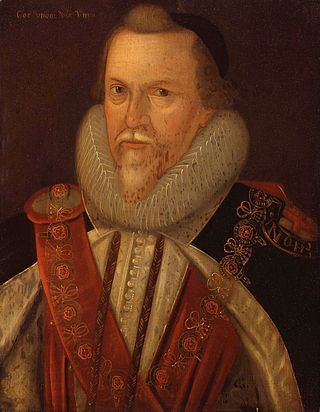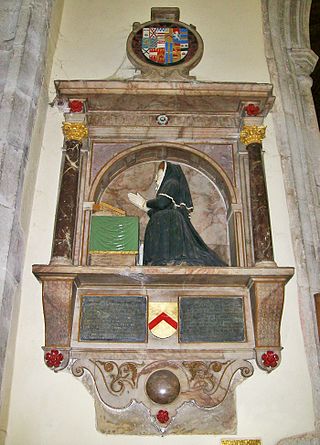Related Research Articles

Thomas Cecil, 1st Earl of Exeter, KG, known as Lord Burghley from 1598 to 1605, was an English politician, courtier and soldier.
Elizabeth, Lady Coke, was an English court office holder. She served as lady-in-waiting to the queen consort of England, Anne of Denmark. She was the daughter of Thomas Cecil, 1st Earl of Exeter, and Dorothy Neville, and the granddaughter of William Cecil, 1st Baron Burghley. She was the wife of Sir William Hatton and later of Sir Edward Coke.

Edward Cecil, 1st Viscount Wimbledon was an English military commander and a politician who sat in the House of Commons at various times between 1601 and 1624.
Jean Ker, Countess of Roxburghe, néeDrummond (c.1585–1643) was a Scottish courtier, serving Anne of Denmark in Scotland and England.

Elizabeth Stafford, also known as Dame Elizabeth Drury and – in the years prior to her death in 1599 – Dame (Lady) Elizabeth Scott, was a Lady of the Bedchamber to Queen Elizabeth I. She and her first husband, Sir William Drury, entertained Queen Elizabeth I at Hawstead in 1578.

Francis Annesley, 1st Viscount Valentia, was an English statesman during the colonisation of Ireland in the seventeenth century. He was a Member of Parliament for both the English and Irish houses, was elevated to the Irish peerage as Baron Mountnorris, and later gain the additional title Viscount Valentia. He is best remembered for his clash with the Lord Lieutenant, Thomas Wentworth, who in order to render Annesley powerless had him sentenced to death on a spurious charge of mutiny, although it was clearly understood that the sentence would not be carried out.
Richard Annesley, 6th Earl of Anglesey, known as The Lord Altham between 1727 and 1737, was an Irish peer and governor of Wexford. He is known for the doubts surrounding his claim to the barony of Altham, for the questionable legitimacy of his marriages and therefore of his son's claim to his titles, and for his arranging the kidnapping of his nephew, a rival claimant to his titles and estates. This incident is believed to have influenced part of the novel Kidnapped by Robert Louis Stevenson.

Susan Herbert, Countess of Montgomery, was an English court office holder. She served as lady-in-waiting to the queen consort of England and Scotland, Anne of Denmark. She was the youngest daughter of Elizabethan courtier, and poet Edward de Vere, 17th Earl of Oxford.
Sir William Uvedale was an English politician who sat in the House of Commons at various times between 1614 and 1645. He supported the Royalist cause in the Civil War.
Sir Robert King was an Irish soldier and statesman.
Barbara Ruthven was a Scottish courtier and favourite of Anne of Denmark, expelled from court after the death of her brother.
Sir Edward Zouch of Woking was a courtier to English kings James and Charles I, a masque actor, and Knight Marshal of the King's Household.
Bridget Annesley was a courtier to Anne of Denmark, wife of James VI and I.
Mary Gargrave was a courtier to Anne of Denmark.
Sarah Harington (1565–1629) was an English courtier.
Dorothy Hastings was a courtier to Elizabeth I of England and Anne of Denmark
Dorothy Speckard or Speckart or Spekarde was a courtier, milliner, silkwoman, and worker in the wardrobe of Elizabeth I of England, Anne of Denmark, Prince Henry, and Henrietta Maria. Her husband, Abraham Speckard, was an investor in the Somers Isles Company which colonised Bermuda.
Cordell Annesley was an English courtier.
Henry Middlemore was an English courtier and diplomat.
Christophe de Harlay, Count of Beaumont (1570–1615) was a French politician and diplomat who served as ambassador to England.
References
- ↑ William Shaw, Letters of Denization and Naturalization, Huguenot Society, vol. 18 (Lymington, 1911), p. 16.
- ↑ Charles Dalton, Life and times of General Sir Edward Cecil, viscount Wimbledon, 1605-1631 (London, 1885), p. 374.
- ↑ Jemma Field, 'The Wardrobe Goods of Anna of Denmark', Costume 51:1 (2017), pp. 20-1.
- ↑ Diana Scarisbrick, 'Anne of Denmark's Jewellery Inventory', Archaeologia, vol. CIX (1991), pp. 193–237, at p. 196.
- ↑ Colin J. Brett, Crown revenues from Somerset and Dorset, 1605 (Somerset Record Society, 2012), pp. 8-9: Corston is included in a list of the queen's manors, TNA SP 14/4 f.24.
- ↑ Mary Anne Everett Green, Calendar State Papers Domestic: James I: 1603-1610, vol. 1 (London, 1857), pp. 552, 605: TNA SP14/48/159-160, SP14/53/185: Calendar of the Cecil Papers in Hatfield House: Volume 21, 1609-1612, ed. G Dyfnallt Owen (London, 1970), 11 Sept 1609.
- ↑ Alice Clark, The Working Life of Women in the Seventeenth Century (London, 1919), p. 25: British Library Lansdowne MS 166/63 (as "Cousham", probably in confusion with "Corsham" another manor in the jointure).
- ↑ William Arthur Shaw, Letters of denization and acts of naturalization for aliens in England and Ireland (Lymington, 1911), pp. 15-6.
- ↑ Folger Shakespeare Library, catalogue X.d.572
- ↑ William Knowler, Strafford Letters, vol. 1 (London, 1739) p. 468: Charles Dalton, Life and times of General Sir Edward Cecil, viscount Wimbledon, 1605-1631 (London, 1885), p. 354.
- ↑ Archibald Constable, Memoirs of George Heriot (Edinburgh, 1822), p. 219.
- ↑ John Nichols, Progresses of James First, vol. 3 (London, 1828), p. 541.
- ↑ Arthur J. Collins, Jewels and Plate of Queen Elizabeth (London, 1955), pp. 149, 306.
- ↑ HMC 6th Report (Earl of Denbigh), p. 283.
- ↑ John Trevor Cliffe, The World of the Country House in Seventeenth-century England (Yale, 1999), p. 93.
- ↑ Cases Argued and Decreed in the High Court of Chancery, 1660-1697 (New York, 1828), p. 80-1: Cases argued and decreed in the High Court of Chancery from the 12th year of King Charles II to the 31st (London, 1697), pp. 80-2, these notes have "Dame Dorothy" for "Beatrice": Francis Annesley & Patrick Little, 'Providence and Posterity: A Letter from Lord Mountnorris to His Daughter, 1642', Irish Historical Studies, 32:128 (November 2001), pp. 556-566: Papers relating to the case are held by TNA CS108/107.
- ↑ Brayley & Britton, A Topographical History of Surrey, vol. 2 part 1 (Dorking & London, 1842), p. 9.
- ↑ Francis Annesley & Patrick Little, 'Providence and Posterity: A Letter from Lord Mountnorris to His Daughter, 1642', Irish Historical Studies, 32:128 (November 2001), pp. 556-7.
- ↑ Charles Dalton, Life and times of General Sir Edward Cecil, viscount Wimbledon, 1605-1631 (London, 1885), p. 342-3, 374, 404.